Tahiti Pearls, Black Pearls, Gray Pearls:
Become an expert on these magical treasures
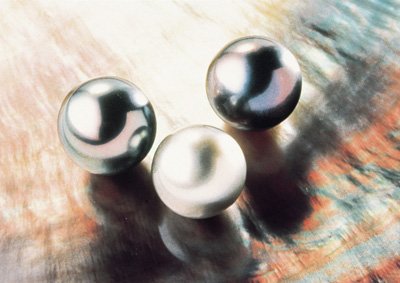 © GIE Tahiti Tourism – GIE Perles de Tahiti
© GIE Tahiti Tourism – GIE Perles de TahitiLustrous black Tahiti pearls were once so rare that they were considered the 'Pearl of Queens'. Tahitian black pearls have been so highly sought after because they are larger, have a more brilliant luster, and round shapes occur in a higher percentage. Also, far less are produced per oyster than fresh water pearls.
Now that this 'Queen of pearls' is being cultured in the turquoise Polynesian lagoons, you too can have some to cherish. It's rewarding to learn about types of pearls, and their differences, before buying Tahitian pearl jewelry. You may also want to explore how pearls are made.
This page is packed with useful information about what to look for, when shopping for pearls, and how to spot imitations.
What Defines Cultured Tahiti Pearls?
The French Polynesian trade association, GIE Tahiti Pearls has specific criteria for using the label 'Tahiti Cultured Pearl':
- This official term is used exclusively for Tahitian black pearls that have been formed by grafting locally cultivated Pinctada Margaritifera oysters.
- 80% of the pearl's surface must be coated with a continuous pearly layer (called nacre) and neither the nucleus, or the seed of the nucleus can be showing.
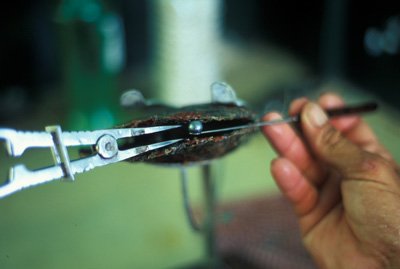 A pearl being extracted from the Oyster © GIE Tahiti Tourism – Cile Flipo
A pearl being extracted from the Oyster © GIE Tahiti Tourism – Cile FlipoTahiti Pearls are officially rejected if:
- more than 20% of the surface lacks normal pigmentation
- the surface is dull and without luster
- more than half of the surface has deep imperfections
- there are deep and shallow imperfections on more than half of the surface
How are Tahiti Pearls Graded?
The Tahitian system for grading Tahitian black pearls, and other salt water pearls like South Sea pearls, has been developed by the Polynesian Government. It rates them from A to D. Any pearls lower than D are not allowed to be exported and are used to make pearl powder.
Know how to buy pearls
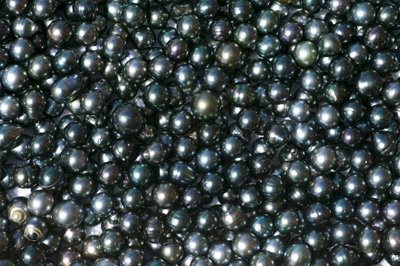 © GIE Tahiti Tourism – Philippe Bacchet
© GIE Tahiti Tourism – Philippe BacchetTahiti Pearls vary in color, shape, quality and size. When a farm harvests Tahiti pearls the imperfect ones are rejected. The pearls are then sorted according to shape, diameter and quality of the surface coating.
Selecting Tahiti Pearls for size
Pearls are arranged according to size by passing them through sieves. They are measured at their narrowest diameter. Most have a diameter measuring between 8mm and 14mm. A few exceptional ones reach between 16mm and 18mm. The largest black pearl diameter recorded was a superb 21mm. The largest baroque (26.95mm) can be seen in the Musee de la Perle in Papeete. Pearls exceeding 18mm are rated as 'A' regardless of color.
Selecting Tahiti Pearls for color
Although they are called black pearls, Tahiti pearls form with a wide range of predominant body colors. And yes, they are natural. The depth of color is determined by the amount of black pigment an oyster secretes. You can choose from soft gray pearls to deep black ones. Or colors of brown, blue and green. Muddy colors are unpopular. Usually, the darker the color, the more valuable the pearl.
The varying shades are created by the refraction of light as it passes through the multitude of pearly layers which act as a prism. This is the same principle whereby raindrops passing through light form a rainbow.
The body color is usually enriched by at least one overtone. The Tahiti pearls considered most exquisite also have a peacock green overtone. You can expect to pay twice the price (of a solid black pearl) for those with this greenish luster. Other desirable overtone colors are blue, silver, gold, pink and aubergine.
|
In the industry, specific names have been given to these overtone colors:
|
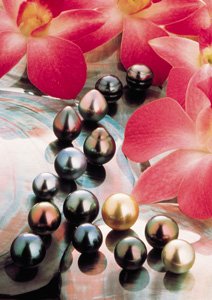 © GIE Tahiti Tourism – Alain Nyssen © GIE Tahiti Tourism – Alain Nyssen |
Most pearl experts advise that you choose the color that looks best on you and take into consideration your skin, hair and wardrobe colors. Some recommend you choose what's fashionable in your home country. Because price varies according to color, you will want to factor in cost. Eye catching multi-colored strands are popular in French Polynesia.
Selecting Tahiti Pearls for shape
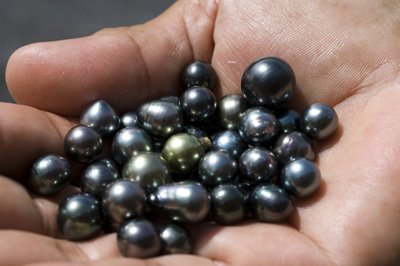 © GIE Tahiti Tourism – Philippe Bacchet
© GIE Tahiti Tourism – Philippe BacchetRound pearls must be an almost perfect sphere with less than 2% variation in diameter measurements. Because pearls grow for 18 months to 2 years inside an oyster, it is unusual to have perfectly spherical nacre. Experienced sellers say that it is rare to have 10% of actual rounds from a crop, and they are usually only about 5% of harvesting. The percentage becomes even less when the heavily blemished ones, that are unsellable, are removed. This gives you an understanding of why cultured black Tahitian pearls are so valuable.
Semi-round pearls have variations in diameter of greater than 2%, but less than 5%, so are slightly imperfect. There are larger numbers of semi-rounds harvested and they can be purchased for much less. So they are popular for black pearl jewelry, such as a Tahitian pearl necklaces, as slight deviations from round can be concealed.
Semi-baroque pearls are grouped into 4 shapes: oval, pear, drop and button. They must have at least 1 axis of rotation to fit into this category. Drop pearls are a favorite for use in black pearl jewelry.
Baroque pearls have no axis of rotation. Due to their affordability, they are appreciated by some jewelers. These manufactures specialize in creative designs that integrate fancy baroque shaped pearls into fabulous pieces of Tahitian pearl jewelry.
Ringed or circle pearls have an axis of rotation and exhibit regular rings, streaks or grooves that are perpendicular to the axis. As a plus, they are imbued with multiple hues of color. 'Ringed pearls' make up 25% to 30% of a pearl farm harvest, so are common. Their prices are attractive to designers. So they use this feature by setting bands of precious metal into the grooves of circle pearls, and accent them with gem stones such as diamonds.
Selecting cultured Tahiti Pearls for quality
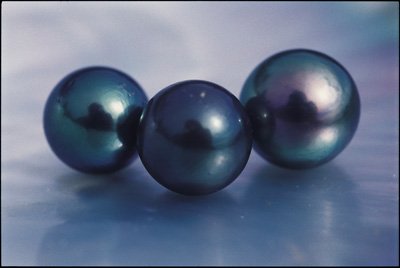 © GIE Tahiti Tourism – Philippe Bacchet
© GIE Tahiti Tourism – Philippe BacchetNacre thickness
Black pearl jewelry that has a thick coating of nacre can be worn often
and stay beautiful through time. But if pearls have a thin nacre coating
it will gradually wear away and expose the nucleus shell.
Luster
This is the sheen that reflects light on the pearl's
surface. When light reflections are bright and sharp, a pearl's luster
is considered high or very high. If light reflections are weak, the
pearl's luster is called dull.
Tahiti cultured pearls can have a remarkable glossy finish which
radiates warmth, along with a mirror-like sheen. This lustrous finish is
prized by many.
Because pearls formed in the natural environment (rather than being grafted on farms) have a soft, satin surface, some jewelers prefer cultured pearls with less luster. When you look around the Tahiti pearl shops you will see both matte and shiny black pearl jewelery. Be assured that like their color, the luster of Tahiti pearls is natural.
Surface
Four ratings are given for surface quality:
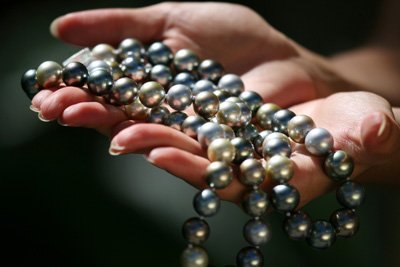 © GIE Tahiti Tourism – G.Le Bacon
© GIE Tahiti Tourism – G.Le BaconWhere to buy your pearls?
Tahiti pearls are so precious that a small pearl of average quality costs about $100 and a round pearl of perfect quality with a diameter of 18mm sells for about $10,000. So it is not surprising that attempts are made to imitate them. Fortunately imitations are detectable. However, careful consideration must be given to where to buy pearls. There are specialist stores in Tahiti where you can sit in comfort and individually choose each pearl to be made into a treasured Tahitian pearl necklace. It is best to shop with a reputable black pearl specialist when buying pearls. Here are the black pearl shops and pearl Farms you can visit while you are in Tahiti. If you want an 'only in paradise' shopping experience, here's our favorite pearl jewelry designer.
Here's useful information on where to buy Tahiti Pearls.
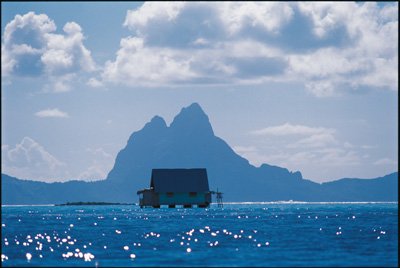 Taha'a Pearl Farm © GIE Tahiti Tourism – T.Zysman
Taha'a Pearl Farm © GIE Tahiti Tourism – T.ZysmanImitation black Pearls
It is very difficult to replicate real black pearls because of the rich variations in their hues and overtones. Tahitian black pearls have a color that is far from being a matte black. And real pearls have a beautiful sheen overlaying the black underlay. However imitations do exist, so here are some of the ways to detect them.
Giveaway signs of imitations
A graduated choker necklace with large sized beads and matching color and symmetry would literally cost a fortune, so could not be real pearls. The drill-hole on pearls is also a means of detecting imitations. Imitation pearls have a roughness or unevenness as they lack the finish given to cultured Tahiti pearls. Cultured pearls are individually drilled and so very precise.
A 10X lens
A 10x lens identifies imitation pearls. On examination you can see bubbles just beneath the surface, or a mat pattern which is completely different to that of real pearls.
X-ray & infrared photography
Less popular colors of cultured pearls, that are hard to sell, may be treated with silver nitrate. A pearl picks up silver nitrate precipitate and this turns black when exposed to light or hydrogen sulphide gas and produces a long lasting black color. Some types of X-ray and infrared photography detect the treated color's lack of ultraviolet fluorescence and it's response to dilute acids.
Ultraviolet light
Another method used to alter the color of cultured pearls is radiation. This creates shades of gray or bluish gray that are permanent but doesn't make the pearl radioactive. Long-wave ultraviolet light usually reveals a reddish fluorescence on natural black or dark pearls but colors created by radiation have a yellowish fluorescence like that of fresh water pearls.
Home › Tahiti Pearls
Search the Site
Are you still looking for additional information? You can use the Google search box below to search the site.
Site Sponsors
Subscribe to receive free Bora Bora updates
Top Tours
Photo of the day
All of us at Bora Bora Island guide love to have fun, but we also have to keep the site up and running! That's why you'll see ads on this site. We may also earn commissions on some of the products on this site.
The income generated through these means helps ensure
Bora Bora Island Guide can devote the time to providing you
with all the free and fabulous information & resources you'll
find here. If you would like to support us, you can purchase our book full of over 100 pages of money saving tips or find out the best activities, resorts, dining and beaches in our Best of Bora Bora book or buy our 2018 Bora Bora calendar.
Want to learn more? Bora Bora Island Guide invites you to read our advertising disclosure.


















New! Comments
Have your say about what you just read! Leave me a comment in the box below.